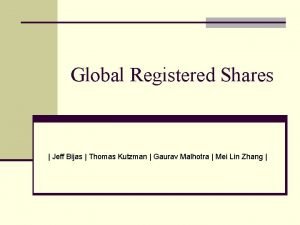Registered participants 66 16 participants from outside Cern




- Slides: 4

• Registered participants 66 • 16 participants from outside Cern

• Idea for the workshop dates back to about 2. 5 years ago when CLIC Machine Protection activities (and CDR) were starting. • Initially foreseen as a MP workshop with members from LHC to profit from experience of LHC • IWLC 2010 in Geneva: Enlarge the scope and look for synergies with other institutions with similar requirements. • Delayed because of CDR write-up activities. • Organization planning taking off at IPAC 11 • During the work-shop we should think and discuss possible follow -ups, further work-shops, scope, etc. . .

Workshop Objectives: • Bring together experts working on machine protection systems for accelerator facilities with high brilliance or large stored beam energies, with the main focus on linear accelerators and their injectors. • Establish a coherent view of failure modes and consequences for linear accelerators. • Review the current state of the art in machine protection systems. • The participants will benefit from the experience of colleagues who have designed, commissioned and operated such systems. • The workshop will provide input to the design of machine protection systems at future accelerators, in particular for CLIC and ILC. • It also should promote synergies in the development of protection systems at different accelerators.

Wednesday (experience and future needs) • • Machine protection and operational availability, issues and solutions. Review of existing solutions and challenges faced by future installations: Beam loss mechanisms. Experience of existing and previsions for future accelerator complexes, addressing three types of beam losses and their potential impacts: – Operational beam losses, Equipment failure induced beam losses, Transient beam losses, or beam losses related to changing environment (temperature drift, ground motion, ufo, others). Thursday (instrumentation and technology) • • Failure onset detection. This section will address the detection of failures that may lead to uncontrolled beams. – Beam Quality Assessments (for active systems and Post Pulse Analysis) – Equipment failure detection Failure mitigation. Reviews of various types of failure mitigation: – Passive protection (masks , materials, collimators, non linear optics), RT protection, Safe by design, Interlock systems (equipment and post pulse assessment) Friday • • • Operational aspects (commissioning, intensity ramp, machine availability) Risk assessment: management and tools Summing up and conclusions







